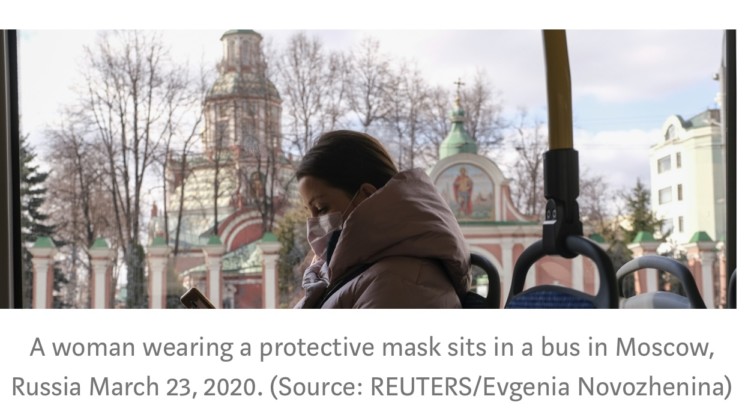The Kremlin’s long-term strategic goal in the information sphere is enduring and stable: undermining Western unity while strengthening Kremlin influence. Pro-Kremlin information operations employ six complementary tactics to achieve that goal, and the ongoing disinformation campaign on COVID-19 is no exception.
1. Spread anti-US, anti-Western, and anti-NATO messages to weaken them
Russian media started spreading false accusations that COVID-19 was a biological weapon manufactured by the United States in late January. The claim has appeared in other languages since then. This messaging is in line with decades of Soviet and Russian propaganda that has been fabricating stories about various diseases allegedly being a U.S. creation at least since 1949.
These messages aim to deepen anti-American, or more generally, anti-Western sentiment. Sometimes, the “perpetrator” is the entire NATO alliance, not just the United States, a variation that the DFRLab has traced in languages other than Russian as well. The impact on an average consumer of these messages will be approximately the same: anti-Western, anti-NATO and anti-U.S. feelings often go hand-in-hand in Europe.
2. Sow chaos and panic
In the aftermath of a tragedy or crisis, pro-Kremlin media outlets often try to incite fear, panic, chaos, and hysteria. On several occasions, in the aftermath of a terror attack in Europe or the United States, pro-Kremlin outlets spread accusations that the attack was a false flag operation conducted by various governments or secret services against its citizens, or that it was staged to impose greater control over the public.
These campaigns aim to stoke and exploitemotions, among which fear is one of the strongest. An audience shaken by fear will be more irrational and more prone to further disinformation operations.
3. Undermine the target audience’s trust in credible sources of information, be it traditional media or the government
Another messaging tactic tries to convince the target audience that the truth is different from whatever is being said by government institutions, local authorities or the media, thereby undermining trust in credible information sources. Convincing people to believe bogus sources of information first requires persuading them that real sources of accurate information cannot be trusted.
4. Undermine trust in objective facts by spreading multiple contradictory messages
According to a March 2020 review of COVID-19-related disinformation cases conducted by EUvsDisinfo, one popular pro-Kremlin narrative alleges, “[t]he virus is a powerful biological weapon, employed by the U.S., the Brits, or the opposition in Belarus.” A few days after the EUvsDisinfo report, pro-Kremlin outlets then accused Latvia of producing the virus. Spreading multiple and often contradictory versions of events undermines trust in objective facts.
The Kremlin has deployed this tactic liberally: after the MH17 tragedy, after the attack on an humanitarian convoy in Syria, and after the attempted murder of Sergei Skripal. The aim here is not to persuade people to believe one particular version of events, but to persuade the average consumer that there are so many versions of events that the truth can never be found. This tactic can be rather effective: then-U.S. presidential candidate Donald Trump has previously said that “no one really knows who did it” [i.e. shot down MH17] despite available evidence and statements by US authorities.
5. Spread conspiracies to facilitate the acceptance of other conspiracies
People who believe one conspiracy theory are more likely to accept others. If your job is to spread lies, it helps to promote other conspiracies as well. The pro-Kremlin media has a history of spreading conspiracy theoriesand elevating conspiracy theorists. A global pandemic that naturally leads to rumor-mongering is an ideal opportunity to spread some additional unfounded beliefs.
6. Identify the channels spreading disinformation
In his book on disinformation, Romanian defector Ion Mihai Pacepa described “Operation Ares,” which used U.S. involvement in Vietnam to spread anti-American feelings both within the United States and abroad in an effort to isolate the United States on the international scene.
“All we had to do was to continue planting the seeds of Ares and water them day after day after day,” Pacepa wrote. “Eventually, American leftists would seize upon Ares and would start pursuing it of their own accord. In the end, our original involvement would be forgotten and Ares would take on a life of its own.”
When you spread disinformation, you not only try to influence the audience — you also gain valuable information from the audience. You identify the channels through which disinformation spreads and the intermediaries that help disinformation reach new audiences. You also see who counters your disinformation. Especially in a time of crisis, when rumors spread faster and travel further than normal, a well-organized disinformation campaign can lend valuable insight into how an adversary’s information environment is organized. This insight is extremely valuable for any future disinformation operations. Knowing who will help you spread the desired information, and whom to try to discredit ahead of time, makes new disinformation campaigns easier to mount and sustain.
Jakub Kalenský is Senior Fellow with the Digital Forensic Research Lab.






Leave a Reply